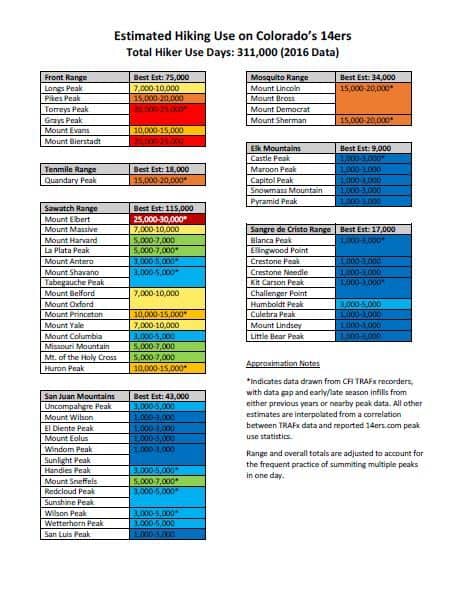 After several years of study, Colorado Fourteeners Initiative is releasing an updated report that estimates that Colorado’s 14,000-foot peaks –the “14ers”– experienced 311,000 hiker use days in 2016. This represents an increase of 51,000 use days compared to CFI’s 2015 estimate of 260,000 hiker use days. Most of the increased use is believed to stem from more accurate hiker counts due to doubling the number of trail counting units—20 in 2016 compared to 10 in 2015. However, there was a 16 percent year-on-year increase in hiking use on Mount Elbert, the state’s highpoint and most-climbed peak, which has had three trail counters in use both years.
After several years of study, Colorado Fourteeners Initiative is releasing an updated report that estimates that Colorado’s 14,000-foot peaks –the “14ers”– experienced 311,000 hiker use days in 2016. This represents an increase of 51,000 use days compared to CFI’s 2015 estimate of 260,000 hiker use days. Most of the increased use is believed to stem from more accurate hiker counts due to doubling the number of trail counting units—20 in 2016 compared to 10 in 2015. However, there was a 16 percent year-on-year increase in hiking use on Mount Elbert, the state’s highpoint and most-climbed peak, which has had three trail counters in use both years.
This level of recreational use suggests a statewide economic impact of more than $84.3 million, based on past 14er-related expenditure studies. Download the report in PDF.
2016 Hiking Use Estimates Press Release–8.18.2017
CFI’s most recent hiking use report culminates three seasons of data collection at up to 20 sites tracking use on up to 23 14er peaks across the state. (There were five counters in 2014, 10 counters in 2015 and 20 counters in 2016.) A data model was developed that helps fill in gaps in the data due to obscured counter sensors or periods in the early or late season when the counter is not in place. This model incorporates the week of the season, day of the week, holidays and representative other peaks with data to fill in missing data. Projections based on crowdsourced 14er “checklists” posted on the 14ers.com website were used to suggest use levels on all other 14ers across the state that did not have a counter. If you want to dig under the hood to learn more about how these estimates were calculated, check out this explanation of the methods used.
CFI has long been interested in the amount of hiking use these popular peaks receive. Colorado’s 14ers are among the most sought-after mountain peaks in the country. They also possess some of the most fragile alpine landscapes. Hiking use is confined into a very short four-month climbing season when the mountains are largely free of snow.
Natural resource impacts in the fragile alpine tundra environment, stemming from the lack of properly designed and constructed summit trails on the 14ers, led to CFI’s founding back in 1994. Our “14er Report Card” released in 2015 showed the need for $24 million to build out and improve the summit trail network. Better understanding hiking use levels, dispersal over the climbing season, and changes over time are important factors in determining the link between hiking use and changing on-the-ground conditions of natural surface summit trails.
CFI has 20 counters out on the 14ers again this summer. The Antero counter was moved to La Plata’s Winfield route, while a few of the monitoring locations were changed on the peaks in hopes of getting more accurate data. Check back next year to see how our estimate of hiking use gets further refined as we look to get the best possible estimates of how many people are out climbing the 14ers each summer. Once we have several years of data, we will be in a better position to comment on long-term trends in hiking use.
Special thanks goes out to Emily Barnes, CFI’s 2016 summer CLIMB intern, who continued to help in the preparation of the hiking use report. Emily performed the analysis for the 2015 study, assisted in placing and downloading trail counters last summer, and continued to tweak the statistical model during her senior year at Yale.
Additional Links:
2015 14er Hiking Use Estimates
Interesting Factoids and Lists – 2015 Estimates
